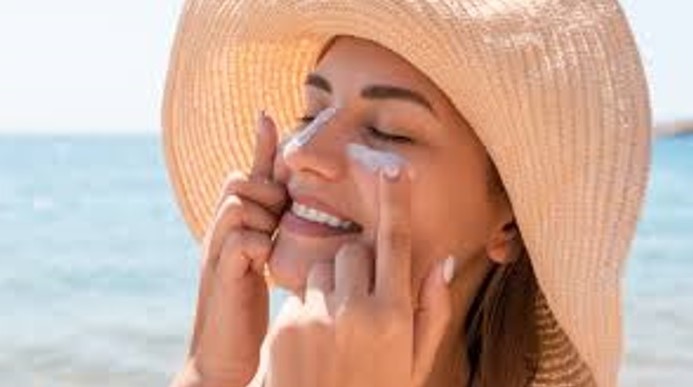Sunscreen, also known as sunblock or sun cream, is a photoprotective topical product for the skin that mainly absorbs, or to a much lesser extent reflects, some of the sun’s ultraviolet (UV) radiation and thus helps protect against sunburn and most importantly prevent skin cancer.
Sunscreens come as lotions, sprays, gels, foams (such as an expanded foam lotion or whipped lotion), sticks, powders and other topical products. Sunscreens are common supplements to clothing, particularly sunglasses, sunhats and special sun protective clothing, and other forms of photoprotection (such as umbrellas).
Sunscreen types
Sunscreens are classified into inorganic (mistakenly called ‘physical’) sunscreens (i.e., zinc oxide and titanium dioxide) and organic (also, mistakenly referred to as ‘chemical’) sunscreens.
Despite popular belief, both types of sunscreens work mainly by absorption of UV light, not by reflecting or scattering it.
Medical organizations such as the American Cancer Society recommend the use of sunscreen because it aids in the prevention of squamous cell carcinomas.The routine use of sunscreens may also reduce the risk of melanoma. However, many sunscreens do not block ultraviolet A (UVA) radiation, yet protection from UVA is important for the prevention of skin cancer.
Research by the FDA on the safety of the main three organic UV filters (oxybenzone, homosalate and octocrylene) found that the three ingredients could be detected on the skin, in blood, in breast milk and in urine samples weeks after no longer being used.
To provide a better indication of their ability to protect against skin cancer and other diseases associated with UVA radiation (such as phytophotodermatitis), the use of broad-spectrum sunscreens has been recommended.
Why you should avoid sunscreen higher than SPF 50?
SPF (short for “sun protection factor”) is a measure of how well a sunscreen protects you from UVB. It seems like an SPF 100 sunscreen would give you double the protection of an SPF 50 sunscreen. But the truth is that higher-SPF products are only marginally better at shielding you from UVB, according to the Skin Cancer Foundation. SPF 30 blocks nearly 97% of UVB radiation, SPF 50 blocks about 98%, and SPF 100 blocks about 99%.
A higher SPF product might also encourage you to stay out in the sun longer. Moreover, researches indicate the higher SPF ,the more side effects due to complexity of ingredients. Instead, choose an SPF between 15 and 50, apply liberally, and reapply often.
Sunscreen side effects
Some sunscreen products (such as those containing aminobenzoic acid or para-aminobenzoic acid/PABA) may stain clothing.
Some ingredients of higher SPF sunscreens can cause the skin to become more sensitive. If a sunscreen causes redness or irritation, wash it off and stop using it. Talk to your doctor about using another sunscreen product with different ingredients.
Avoid sunsreen cream just after skin resurfacing procedures such as or microneedling or CO2 laser for 48 hours, because your skin become more sensitive, instead apply zinc oxide as well as repairing cream.

Higher SPF side effects
A very serious allergic reaction to this drug is rare. However, seek immediate medical attention if you notice any symptoms of a serious allergic reaction, including: rash , itching/swelling (especially of the face/tongue/throat), severe dizziness, trouble breathing.
Sunscreen and breastfeeding
According to FDA Food and Drug Administration only two sunscreen ingredients, PABA and tolamine salicylate, have been found dangerous in nursing mothers.
Some other sunscreen ingredients — including oxybenzone, avobenzone, ensulizole, octisalate, homosalate, octocrylene, and octinoxate — have been used for many years. But the FDA has called for more studies on these ingredientsTrusted Source to confirm their long-term safety.
There are two ingredients that the FDA has established as generally safe for use by all people: zinc oxide and titanium dioxide. They’re natural minerals that physically block the sun’s harmful rays from getting to your skin.
Zinc oxide and titanium dioxide are the main ingredients in physical sunscreens, which are also known as mineral sunscreens.
Sunscreen for kids
Mineral sunscreens are the best for children, people who are pregnant or breastfeeding, and those with sensitive skin.
Mineral sunscreens do tend to be more expensive than their chemical counterparts. You can sometimes buy in bulk and save money.
Broad spectrum and water-resistance
Sunscreen should always be broad spectrum (protects against both UVA and UVB rays), SPF 30 or higher, water resistant (if you will be swimming or sweating), applied 15 minutes before you go outside, and reapplied every 2 hours while you are outside.
Sunscreen night cream
One mistake that people make is using their moisturizer with SPF when they go to sleep as a nighttime moisturizer. There is no need to use SPF at night, as it can unnecessarily dry out the skin or clog the pores.
Sunscreens and sunblocks may potentially be clogging your pores since they contain heavier ingredients used for day time. Certain sun-protection ingredients may clog pores for skin types prone to congestion and breakouts—especially if you sleep on your stomach and your face is constantly in contact with your pillow at night. Also, SPF is a larger molecule and you don’t want it pressing into your skin while you sleep at night, creating larger pores.


Leave a Reply